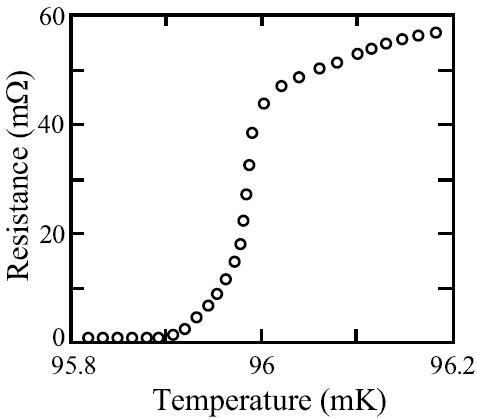Transition-Edge Sensors (TES)
TES sensors take advantages from the temperature dependence of the resistance of a superconductor. Such dependence, as depicted in the figure below, shows a very sharp pattern around the critical temperature ( T=96 mK for the example in the figure) due to the Normal Metal-Superconductor phase transition. As a consequence, an accurate measurement of the temperature of the device is achievable by a simple electrical resistance measurement. Now the way of working of a TES is simple: let imagine that a radiation hits the superconductor, the temperature increrases and this change is detected by the measurements of the resistance adjustment. Therfore TES detectors work by put in relation the incident radiation with the detector electrical resistance change.

TES detectors are being developed for measurements across the electromagnetic spectrum from millimeter through gamma rays as well as with weakly interacting particles and biomolecules. They have contributed to the study of dark matter and supersymmetry, the chemical composition of materials and also they are being used for spectroscopy and astronomical imaging [1].
Temperature-to-Phase Conversion (TPC)
[1] K. D. Irwin and G. C. Hilton, Transition-Edge Sensors. In: Enss C. (eds) Cryogenic Particle Detection. Topics in Applied Physics, vol 99. Springer, Berlin, Heidelberg.
[2] P. Virtanen, A. Ronzani and F. Giazotto, Josephson Photodetector via Temperature-to-Phase Conversion, Phys. Rev. Applied 9, 054027 (2018) .